Round The World and other travels
A frequent flyer's collection of trip diaries
This is: Round The World 2015
Armistice Day in Berlin
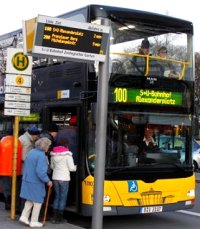 I
woke up at 7:15, but was in no great hurry to leap out of bed. I
eventually ate breakfast in a branch of McDonalds across the street
at around 8:30, wondering - in the aftermath of my arrival by bus
the previous evening - whether this represented another inauspicious 'first' for
a guest at the five-star Waldorf Astoria. Having briefly
returned to my room to get organised and after calling in at the Zoo
Station ticket hall to acquire a day pass for the city's public
transport network, I found myself on the top deck of a No 100 bus.
One of the city's prime tourist routes, this took me to Unter
den Linden in the former Russian Sector, via the familiar
sights of the Victory Column, Schoss Bellevue (the
presidential palace), the Reichstag (home of the federal
parliament) and the Brandenburg Gate. I noticed that the president's
residence was flying its flags at half-mast, and wondered whether
this was because it was 11 November or for some other reason.
(Note: the Paris bombings of November 2015 were still two days away
at this point.)
I
woke up at 7:15, but was in no great hurry to leap out of bed. I
eventually ate breakfast in a branch of McDonalds across the street
at around 8:30, wondering - in the aftermath of my arrival by bus
the previous evening - whether this represented another inauspicious 'first' for
a guest at the five-star Waldorf Astoria. Having briefly
returned to my room to get organised and after calling in at the Zoo
Station ticket hall to acquire a day pass for the city's public
transport network, I found myself on the top deck of a No 100 bus.
One of the city's prime tourist routes, this took me to Unter
den Linden in the former Russian Sector, via the familiar
sights of the Victory Column, Schoss Bellevue (the
presidential palace), the Reichstag (home of the federal
parliament) and the Brandenburg Gate. I noticed that the president's
residence was flying its flags at half-mast, and wondered whether
this was because it was 11 November or for some other reason.
(Note: the Paris bombings of November 2015 were still two days away
at this point.)
 |
 |
| Humboldt University, on Unter den Linden | |
I got off the bus at Humboldt University, having already decided that although there was no tradition of marking Armistice Day in Berlin, my first port of call on this day should really be Neue Wache. It had, after all, now become a memorial to all victims of war.
I had first visited this spot in 1982, after passing through Checkpoint Charlie and into the so-called German Democratic Republic (which, in terms of the second part of its name, was anything but). Neue Wache had once been a 'tomb of the unknown soldier', but the communist regime rededicated it to the "victims of fascism and militarism". A daily Changing of the Guard ceremony took place in those days, which I captured complete with goose-stepping soldiers. All this is long gone, of course. The DDR symbols have been removed from the building and the chamber now houses a Pietà-type sculpture by Käthe Kollwitz (1867-1945), showing a woman clasping the body of her dead son.
| RIGHT: Neue Wache, Germany's central memorial to the victims of war and tyranny, with its Pietà-inspired sculpture by Käthe Kollwitz |
 |
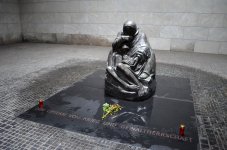 |
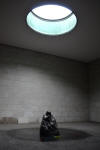 |
 |
 |
 |
LEFT: A few aspects of Museuminsel (Museum Island) |
With 11 November duly observed, I walked the short distance to Museum Island. Although I had been to this area often enough in the past, I had yet to be successful in making it to the inside of any of the fine institutions here. There had been at least two attempts over the years, but both had been thwarted by horrendous queues. My target today was the Old National Gallery and the complete lack of waiting people on this occasion once again affirmed that off-season travel is the way to go. The interesting collection kept me busy for just over an hour.
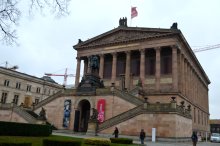 |
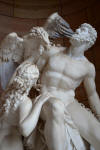 |
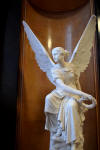 |
 |
 |
|
 |
 |
||||
 |
 |
 |
 |
 |
 |
Strolling in the direction of Alexanderplatz - once the austere focal point of the old East Berlin - in search of lunch, I found a place behind the east end of the cathedral and on the banks of the Spree, where I was able to have a hot soup and a chicken wrap.
| RIGHT: In search of lunch, on a chilly November midday |
 |
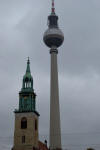 |
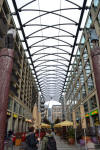 |
 |
 |
 |
 |
After sitting down for an hour or so to enjoy my simple but tasty lunch, I felt I was ready for another bout of sightseeing. Being just a few steps away from Berlin Cathedral, I realised that the next objective was obvious. It would be the second example today of a building that was familiar from the outside, but where I was making my first visit to the interior. It turned out that the building was being prepared for a musical performance of some kind, presumably taking place later the same day, but that did not present a problem.
I usually try to understand the various historical buildings that I visit, but I must admit that I was left somewhat confused by the convoluted story of this structure and its predecessors. I think the salient points were: first, although known as Berliner Dom, it's not actually a cathedral as it is not the seat of a bishop; secondly (and partly explaining the first point), it's not Lutheran, being jointly supervised by all members of the Union of Evangelical Churches; thirdly, the current building was consecrated in 1905, bombed in 1944 and started to undergo a proper restoration programme as late as 1975, a job that continued until 2002, long after German reunification. Having tried to separate the main points from all the rather complex detail of the church's story, I was then happy simply to appreciate the surprisingly ornate - some would say ostentatious - interior for myself.
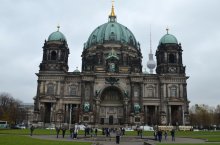 |
 |
 |
 |
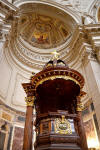 |
 |
 |
 |
When I was finished in the Berliner Dom, I decided to walk to the Gendarmenmarkt in order to catch a train to my final objective of the day, the Deutsches Technikmuseum (German Museum of Technology), which would represent completely new territory for me. I knew from my research that despite its name, this museum had a pronounced slant towards transport, which certainly wasn't a problem for me. It turned out to be a large facility with several buildings and an open-air 'park' section. With two of the buildings being former railway roundhouses - their associated turntables were outside in the 'park' section - it was no surprise at all that the main focus was on railways; however aviation and shipping were also well covered in the impressive, so-called 'new building'. (Impressive, that is, apart from the choice of name!)
 |
 |
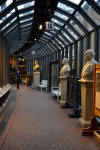 |
 |
 |
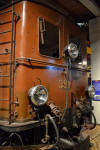 |
 |
 |
 |
 |
||
 |
 |
 |
 |
 |
 |
 |
 |
 |
 |
| The Lang Bar - a fine way to end the day | |||
After all that, I was glad to return to the Waldorf Astoria for a well earned rest. A little later, I revisited the hotel's superb Lang Bar and had a couple of 'Manhattan' cocktails; it seemed thoroughly appropriate in view of the next part of my itinerary. The service and ambience were just as good second time around. Eventually I also ordered a Wiener Schnitzel, which took care of my evening meal.
It was an excellent and classy end to a busy and thoroughly enjoyable day.